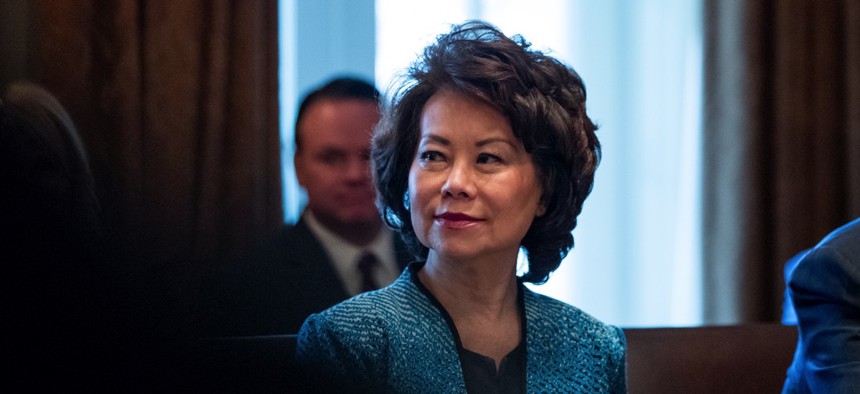Trump's Infrastructure Plan Will Favor States, Localities With Money Lined Up, Chao Says

U.S. Transportation Secretary Elaine Chao (AP Photo/Andrew Harnik)

Connecting state and local government leaders
U.S. Transportation Secretary Elaine Chao also said Monday that the White House would soon release new details about the proposal.
WASHINGTON — U.S. Transportation Secretary Elaine Chao indicated Monday that state and local governments with money lined up for projects would be best positioned to reap federal dollars under President Trump's promised infrastructure program.
“States and localities that have secured some funding or financing of their own for infrastructure projects will be given higher priority access to new federal funds,” Chao said at an event sponsored by the U.S. Chamber of Commerce.
She added that the administration intends to share its “vision of what the infrastructure plan will look like in the next several weeks.”
A document that outlines broad ideas and principles for the proposal, which the secretary seemed to be describing, would serve as only an initial step in the process to get infrastructure investment legislation drafted and moving through Congress.
Later in the day, at a separate event in Washington held by the National Council for Public-Private Partnerships, there was skepticism the White House infrastructure proposal would get much traction in the months ahead.
“You don’t see a center of gravity for infrastructure in the White House,” said Norman Anderson, president and CEO of CG/LA Infrastructure, Inc., a consulting firm that helped to develop a list of possible infrastructure projects for the Trump administration to consider prioritizing.
“It doesn’t seem as if they’ve identified who is in charge of this thing," Anderson also said, speaking during a panel discussion.
Chao said the administration's proposal will call for $200 billion in direct federal funding, which would be used to “leverage” $1 trillion in infrastructure investment over the next decade.
White House budget director Mick Mulvaney publicly shared the $200 billion figure last month.
"A few special projects” that are “not candidates for private investment” but that could boost the nation’s economy or “lift the American spirit” would likely be identified and funded directly by the federal government under Trump’s plan as well, according to Chao.
Los Angeles Mayor Eric Garcetti was also on hand at the Chamber of Commerce event. He voiced support for the Trump administration's preference for funneling federal infrastructure dollars toward jurisdictions that have other funding and financing in place.
“You can’t just come here as beggars, you have to come here with some skin in the game," Garcetti told Route Fifty, referring to local governments turning to Washington for support.
Voters in Los Angeles County, last November, approved a ballot initiative that imposed a half-cent sales tax increase and is expected to generate an estimated $120 billion for transportation costs over four decades. Some of that money is slated to help cover an expansion of Los Angeles' public transit system—including rail lines.
Garcetti did acknowledge that some jurisdictions would likely struggle to come up with money on their own and would need extra assistance paying for infrastructure. "For instance," he said, "American cities have subsidized rural areas for a long time."
The mayor also stressed the importance in his view of preserving funding for a number of existing federal grant and loan programs that help pay for infrastructure.
Examples he offered included: New Starts, which is a Federal Transit Administration program that helps fund undertakings like commuter rail and light rail projects; loans extended under the Transportation Infrastructure Finance and Innovation Act; and the Department of Transportation's Transportation Investment Generating Economic Recovery, or TIGER, grant program, which has supported projects ranging from streetcar lines to rural highway upgrades.
A budget blueprint Trump delivered to Congress in March proposed axing all funding for the TIGER program and limiting funding for New Starts to only those projects covered by existing full funding grant agreements.
The Trump administration is expected to release its full budget proposal next week.
At one point during the panel discussion where Anderson spoke, he asked the audience of about 30 people—which included people closely tracking the administration's plans for new federal infrastructure investment—how many of them thought Congress would pass a $200 billion infrastructure bill this year.
It appeared that one person raised their hand.
“We’re talking as if, you know, something’s going to happen that, I think, is probably not going to happen,” Anderson said.
“And it’s not going to happen next year either, right?" he added. “Because next year’s an election year.”
Lawmakers on Capitol Hill are already confronting other heavy legislative lifts, and an infrastructure bill would be competing for attention and time against those priorities.
The Republican effort to repeal and replace the Affordable Care Act—the health care law also referred to as Obamacare—has progressed to the Senate. Trump is pushing for changes to the federal tax code. And Congress will also have to contend with budget legislation to keep the government operating into the 2018 fiscal year, which begins on Oct. 1.
In explaining the Trump administration's rationale for directing federal infrastructure dollars to places that have secured other financing and funding for projects, Chao noted a 2004 U.S. Government Accountability Office report.
The report, she said, found states and localities were using federal highway money to replace, rather than supplement, what they would have otherwise spent on roadwork.
“This administration wants to retain the primacy of state and local spending," Chao said, "and use federal funding as leverage.”
This post has been updated with additional comments and other information.
Bill Lucia is a Senior Reporter for Government Executive’s Route Fifty and is based in Washington, D.C.

NEXT STORY: Okta identity service gets FedRAMP approval





